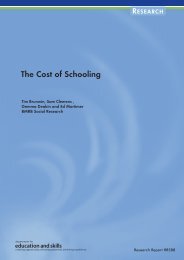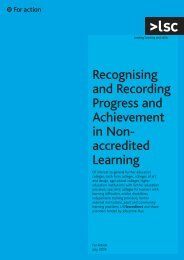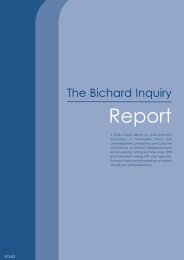The Learning and Skills Councils Annual Report and Accounts for ...
The Learning and Skills Councils Annual Report and Accounts for ...
The Learning and Skills Councils Annual Report and Accounts for ...
You also want an ePaper? Increase the reach of your titles
YUMPU automatically turns print PDFs into web optimized ePapers that Google loves.
Notes to the <strong>Accounts</strong><br />
Accounting policies<br />
1 Statement of<br />
accounting policies<br />
This is the first year that the financial<br />
statements have been presented on<br />
an International Financial <strong>Report</strong>ing<br />
St<strong>and</strong>ards (IFRS) basis (see note 2).<br />
<strong>The</strong>se financial statements have been<br />
prepared in accordance with the<br />
2009–10 Government Financial<br />
<strong>Report</strong>ing Manual (FReM) issued by<br />
HM Treasury. <strong>The</strong> accounting policies<br />
contained in the FReM apply IFRS<br />
as adapted or interpreted <strong>for</strong> the<br />
public sector context. Where the<br />
FReM permits a choice of accounting<br />
policy, the accounting policy which is<br />
judged to be most appropriate to the<br />
particular circumstances of the LSC <strong>for</strong><br />
the purpose of giving a true <strong>and</strong> fair<br />
view has been selected. <strong>The</strong> particular<br />
accounting policies adopted by the LSC<br />
are described below. <strong>The</strong>y have been<br />
applied consistently in dealing with<br />
items that are considered material to<br />
the accounts.<br />
1.1 Going concern<br />
<strong>The</strong> Apprenticeships, <strong>Skills</strong>, Children<br />
<strong>and</strong> <strong>Learning</strong> Act 2009 provides <strong>for</strong> the<br />
dissolution of the LSC <strong>and</strong> the transfer<br />
of functions, staff <strong>and</strong> property to<br />
the Young People’s <strong>Learning</strong> Agency<br />
(YPLA), the <strong>Skills</strong> Funding Agency <strong>and</strong><br />
local authorities. <strong>The</strong> accounts have<br />
been prepared on the assumption that,<br />
under the conventions of Machinery<br />
of Government changes, the LSC’s<br />
functions will continue in operational<br />
existence <strong>for</strong> the <strong>for</strong>eseeable future<br />
albeit through different delivery bodies.<br />
<strong>The</strong> sponsoring departments’ estimates<br />
<strong>and</strong> <strong>for</strong>ward plans include provision<br />
<strong>for</strong> the continuation of the LSC’s<br />
activities in other bodies. Note 16<br />
shows the transfer of the LSC’s assets<br />
<strong>and</strong> liabilities at closure. <strong>The</strong>re<strong>for</strong>e,<br />
these accounts have been prepared on<br />
a going-concern basis.<br />
1.2 Accounting convention<br />
<strong>The</strong>se accounts are prepared under the<br />
modified historical cost accounting<br />
convention, so Property, Plant <strong>and</strong><br />
Equipment, Intangible Fixed Assets <strong>and</strong><br />
inventories are reflected at current<br />
values where the impact of doing so<br />
is material.<br />
1.3 Property, Plant <strong>and</strong> Equipment<br />
Property, Plant <strong>and</strong> Equipment are<br />
carried at fair value. Depreciated<br />
historical cost is used as a proxy of<br />
fair value <strong>for</strong> the following classes<br />
of assets:<br />
furniture <strong>and</strong> fittings<br />
plant <strong>and</strong> machinery<br />
•<br />
computers <strong>and</strong> other IT hardware.<br />
Costs comprise purchase prices<br />
<strong>and</strong> those costs that are directly<br />
attributable to making the asset<br />
capable of operating in the manner<br />
intended by LSC management.<br />
For the purposes of calculating the<br />
current value of Property, Plant <strong>and</strong><br />
Equipment, revaluation is applied<br />
(where material) to the closing<br />
carrying value of assets in use at<br />
31 March using indices prepared by<br />
the Office <strong>for</strong> National Statistics.<br />
<strong>The</strong> minimum level <strong>for</strong> capitalisation of<br />
a Property, Plant <strong>and</strong> Equipment asset<br />
is £5,000. All assets falling into the<br />
following categories are capitalised:<br />
• individual assets which are capable<br />
of being used <strong>for</strong> more than one<br />
year, <strong>and</strong> which have a cost equal to<br />
or greater than £5,000<br />
• groups of assets that individually<br />
may be valued at less than £5,000<br />
but taken together <strong>for</strong>m a single<br />
collective asset because the items<br />
fulfil all of the following criteria:<br />
a. the items are functionally<br />
interdependent<br />
b. the items are acquired at about<br />
the same date <strong>and</strong> are planned<br />
<strong>for</strong> disposal at about the<br />
same date<br />
c. the items are under single<br />
managerial control, <strong>and</strong><br />
d. each individual asset thus<br />
grouped has a value of over<br />
£1,000.<br />
1.4 Intangible Fixed Assets<br />
Intangible Fixed Assets are carried<br />
at fair value that is determined by<br />
reference to an active market where<br />
possible. Where there is no active<br />
market, the LSC uses depreciated<br />
replacement cost as a proxy <strong>for</strong><br />
fair value.<br />
<strong>The</strong> majority of Intangible Fixed Assets<br />
comprises computer software systems<br />
that have been developed exclusively<br />
<strong>for</strong> the LSC. Expenditure on research<br />
of such systems is recognised as<br />
expenditure when incurred. Where<br />
separately identifiable, development<br />
expenditure to support the creation of<br />
a software system is capitalised where<br />
the LSC can demonstrate all of the<br />
following criteria:<br />
a. completion of the system is<br />
technically feasible <strong>and</strong> adequate<br />
resources are available to do so<br />
b. an intention to complete the<br />
system <strong>for</strong> use<br />
c. ability to use the system<br />
d. how the system can generate<br />
future economic benefits<br />
e. attributable development<br />
expenditure can be reliably<br />
measured.<br />
Computer software licences are<br />
capitalised if they are capable of being<br />
used <strong>for</strong> more than one year <strong>and</strong> have<br />
an initial cost, individually or as a<br />
group, equal to or greater than £5,000.<br />
1.5 Depreciation<br />
<strong>The</strong> depreciation methods that best<br />
reflect the pattern of the consumption<br />
of economic benefits <strong>and</strong> the periods<br />
over which such benefits are expected<br />
to be consumed by the LSC are<br />
summarised in the table overleaf.<br />
Finance<br />
LSC <strong>Annual</strong> <strong>Report</strong> <strong>and</strong> <strong>Accounts</strong> 2009–10 49
















